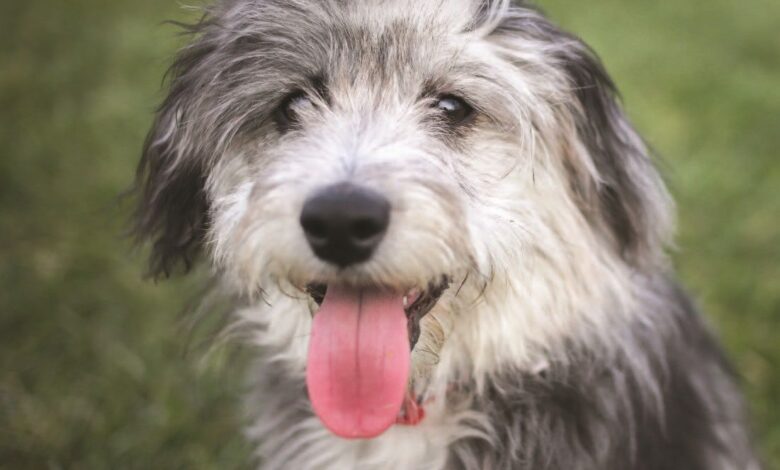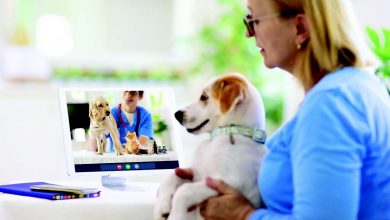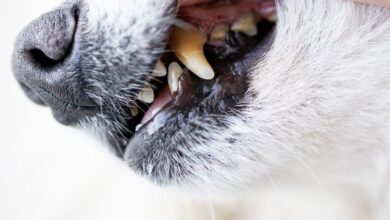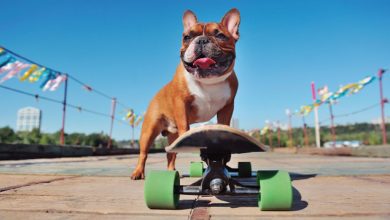Oodles and Oos! – Dogster

[ad_1]
First of all, what exactly is a designer dog? “A designer dog is a purposeful cross between two purebred dogs,” says Michele Brodsky, public relations director of the Australian Labradoodle Association of America (ALAA), which protects the welfare of Labradoodles and Australian Labradoodles. “A crossbreed, or designer dog, breeds two different recognized pure breeds together, resulting in dogs with a wider variety of genetics than a purebred dog. A purebred dog is a dog that has been bred for many generations to an official breed standard resulting in predictability and consistency in offspring.”
While “crossbreed” is often the term used for these mixes, Rhode Islandbased Kathryn Lee, Goldendoodle breeder and author of Goldendoodle, sees a distinction. “A crossbreed can refer to any combination of genetics, naturally occurring in nature, without much thought or intentional purpose, in the offspring. Conversely, a designer dog is ‘purely’ bred with great thought in combining qualities of two or more closed genetic pool breeds, to enhance good characteristics of the parents in the offspring.”
Who wants some Poodle?
Most popular designer dogs would not exist without the Poodle — the peanut butter to various jellies in these crosses. Mostly that’s because of the low-shedding, low-allergen coat. However, although Poodles definitely are a better option for allergy sufferers, there is still some risk. Kathryn says it cannot be guaranteed that a certain dog won’t shed or that a certain person won’t have a reaction. “Even hairless dogs can cause allergies, and dog saliva is more of a culprit than dander can be. A good allergist will tell clients that there is no such thing as a hypoallergenic dog per se.”
According to Miriam Fields Babineau’s book, Labradoodle, it’s not just the Poodle’s coat that makes it desirable. After all, the Portuguese Water Dog and Bichon Frise are other low-shedding breeds.
It’s also because the Poodle has a long history far beyond the foufou stereotype of fancy haircuts and ribbons. “It is also the breed’s temperament and behavioral tendencies. Poodles are intelligent, work-driven and loyal,” the book states. “They are eager to learn. They are one of the oldest breeds known to modern man, having been used as hunting partners to retrieve water fowl, as they are spectacular swimmers.”
All the Poodle crosses have a reputation for being good with families. But size matters. If you have an energetic household that loves outdoor activities, you may prefer a larger dog. Conversely, smaller dogs may be too fragile for small children. And because Poodles come in multiple sizes, from tiny toys to statuesque standards, they can be crossed with other breeds both large and small. The most popular designer crosses are Goldendoodles (Golden Retriever and Poodle) and Labradoodles (Labrador Retriever and Poodle).
While their popularity exploded more recently, they were first developed in the 1970s. Given that time frame, it may appear as if that era’s shag rugs were the inspiration; however, Goldendoodles and Labradoodles were first developed to be service dogs, a trait that continues to this day.
“Labradoodles are smart, focused, friendly, intuitive and easy to train to make them suitable for therapy and service dog work,” Michele says. “They are often used as seizure alert dogs, emotional support dogs and disability service dogs.”
Interestingly, Labradors are already part Poodle. They were originally developed from crosses between Newfoundlands, Poodles and Water Spaniels, according to Labradoodle.
The Labradoodle’s coat can be curly, wavy or woolly. The woolly, or fleece, coat is the one of choice for allergy sufferers. The most common coat colors are black or gold and tan. Others include cream, apricot, silver, red, blue and brown.
Again, the size of the Poodle used in breeding tends to dictate the size of the Labradoodle. Labradors bred with a Standard Poodle might result in males weighing 55 to 80 pounds, with females being 45 to 60 pounds. There are even variations within sizes. For example, if a larger Miniature Poodle is used, the weight of the offspring could range from 40 to 55 pounds. If a small Miniature Poodle is used, that drops to 26 to 55 pounds.
The other very popular large-breed doodle, Goldendoodles, come from Golden Retrievers and Poodles, both with strong hunting, retrieving and water-loving backgrounds. Both breeds are very smart and easily trained.
While not AKC-recognized, many of the designer dog crosses do have “breed standards.” According to Kathryn, the guidelines for standard-sized Goldendoodles are males weighing 55 to 75 pounds, with females 45 to 65 pounds. Goldendoodles sired by Miniature or Toy Poodles range from 25 to 45 pounds. In those instances, the Poodle is the stud via artificial insemination and the Golden Retriever is the mother. Goldendoodles come in more colors than they don’t: They are found in white, cream, black, silver, brown, light and dark apricot, and multicolor.

Hybrid Vigor
The term “hybrid vigor” has been used by many to describe these breed crosses. Rhode Island-based Kathryn Lee, Goldendoodle breeder and author of Goldendoodle, explains: “Hybrid vigor happens when you breed within or across breeds to produce higher levels of heterozygosity in offspring than in their parents, which results in general vigor and vitality. “Inbreeding is when you breed close relatives together to set certain traits in a breed. However, inbreeding results in homozygosity, which causes a loss of vigor by slowly and steadily compromising the health and productivity of the breed over generations.”
There are many more doodle mixes and all are ridiculously cute. Remember, because they all are part Poodle, it means these dogs will be intelligent and energetic. If you are looking for a couch potato dog, these are not your match. Check out these other popular doodles:
Aussiedoodle: Combination of Poodle, usually Standard or Miniature, and Australian Shepherd. They come in three sizes: Toy, Miniature and Standard and range from 10 to 45 pounds. Known for being friendly, clever and highly active.
Australian Labradoodle: This is a mix of Labrador Retriever, Poodle and Cocker Spaniel. They come in three sizes: Standard, Medium and Miniature plus two coat types: fleece and wool. Both coat types are low to non-shedding, so allergy strugglers looking for an intelligent and trainable dog gravitate toward this dog.
Schnoodle: While both Schnauzers and Poodles come in different sizes, a Schnoodle is often a cross between a miniature Schnauzer and a Miniature Poodle. They do need daily exercise, but their small size lends them to life in a condo or apartment.

“Oo” la la!
For whatever reason, the larger crosses have oodle names, while the smaller dogs are oos. And those smaller crosses are no less popular, with Cockapoos and Yorkipoos leading the pint-sized pack. These crosses, too, are plagued by myths. As author Mary D. Foley states in her book Cockapoo, “The Cockapoo is a hybrid, not a mutt. A mutt is a dog of unknown parentage.”
The book also points out that the Miniature Poodle is most often used, along with Cocker Spaniels, of course, adding, “Like Poodles, Cockers have excellent noses for scenting, and are great swimmers and retrievers. They are also known to be very intelligent and quick learners.”
But there is a big difference that allergic prospective owners should be aware of: Cocker Spaniels tend to shed. A LOT. So, again, depending on the exact dog’s genetics, it may be more Poodle or more Cocker in that regard. Micheline Clawson, a pup advisor and trainer specializing in Maltese and Yorkie mixes, based in Ocala, Florida, heartily recommends the smaller “oo” crosses. “They’re very good for allergy sufferers,” she says. “They’re a nice size for apartments or carrying with you and traveling. People love the various colors that are possible. They are great for a first-time dog owner!”
Micheline has personal experience with Yorkipoos — a full Yorkie with a full Toy Poodle. “I have raised and bred Yorkiepoos, first generation, 20-plus years ago before they called them a designer breed.”
She can also attest to their popularity with others, even those who may not seem obvious. “I’ve never found a man yet that didn’t like a Yorkiepoo,” Micheline says. “They’re great for kids and men because they love to play, fetch balls and are active but not crazy.” She also touts them for not barking much, generally not being stubborn and having easy coats to care for.
Can’t get enough oos? Here are several more popular ones:
Cavapoo: This crossbreed of a Miniature Poodle and a Cavalier King Charles Spaniel is a small dog that packs in high intelligence and high energy. They can make good therapy dogs with proper training and socialization. Also called Cavoodle or Cavadoodle.
Doxiepoo (or Dachsiepoo): With Dachshunds coming in smooth, longhaired and wire-haired coats, not to mention the body type difference between a Dachshund and a Poodle, there are several mysteries of how these puppies will look. Known for being playful, affectionate and easy to train.
Llasapoo: The fuzzy combination of a Poodle and Lhasa Apso. Even though this mix is considered low shedding, its coat will still need frequent brushing, perhaps daily.
Maltipoo: A mix of a Maltese with a Poodle, either toy or miniature. Often reported to maintain both puppy-like looks and enthusiasm throughout adulthood.

Pekeapoo: No, not a hide-and-seek game — this is an extra cuddly looking Pekingese and Poodle that tends to grow to 10 to 15 pounds.
Pugapoo: With sizes ranging from 10 to 30 pounds, plus multiple coat colors and types, as well as variety in their tails (either curly or straight), you may be hard-pressed to find two Pug and Poodle crosses that look alike. Pugs are heavy shedders, so the low shedding qualities of the Poodle could be offset in the offspring, depending which parent passes on more dominant traits.
Pomapoo: Typically the offspring of a Pomeranian and a Toy Poodle, this is a tiny package of fluff at 5 to 15 pounds. Because of their small size, they are not ideal in households with small children who may play rough.
Shihpoo: Bless you! This cross between a Shih Tzu and a Toy or Miniature Poodle comes in many colors and two coat varieties — curly or straight. Their look and cuddliness has earned them the nickname of “teddy bear” dogs.
It doesn’t matter if you refer to your pup as a designer dog, a crossbreed or a rescue with unknown pedigree. All dogs are worthy of oodles of love.
‘Doo Diligence: What to ask
Just as with any breed of dog, a prospective owner should do their “doo diligence” when it comes to purchasing an oodle or oo cross. Many experts recommend asking the ‘oodle or ‘oo dog breeder for the following basics:
✤ At least three references.
✤ Written warrantees for health and temperament.
✤ Info on genetic tests that have been run.
Kathryn Lee, Goldendoodle breeder and author of Goldendoodle, elaborates on the health questions. “A wise buyer should ask breeders what research of parent lines have been completed to rule out known genetic problems they do not share and which genetics make them compatible.” She gives this example: If a breeder knows that the two parent lines are known for herding and needing lots of exercise, the offspring aren’t prime candidates for calm families or apartment dwellers.
It’s that kind of research that is part of the fee when getting a dog from a reputable breeder. “What you pay for a breeder includes the selection and meeting of the parents, raising the puppies and after-purchase support. They will be able to provide you with the parents’ hip and eye clearances,” Kathryn adds.
In contrast, unscrupulous breeders don’t research their parent breeds to make sure they’re good prospects for achieving offspring with hybrid vigor, Kathryn says.
If you’re specifically looking for an oodle or oo cross, you may not have much luck adopting. “They seldom wind up in shelters if created by responsible breeders, who ask that all their pups be returned directly to them and not a shelter,” Kathryn says.
“Australian Labradoodle Association of America Member Breeders are bound by our Code of Ethics to assist in the re-homing of one of their puppies should that become necessary,” confirms Michele Brodsky, public relations director of the ALAA. “This is part of responsible breeding. When looking for a puppy, families should look for breeders that belong to an organization that has rules, standards and ethics to protect the breed.”
Finally, expect a breeder to ask you some questions, as well, to assess your understanding of one of these crosses. “I don’t take a deposit but I demand education,” says Micheline Clawson, a pup advisor and trainer specializing in Maltese and Yorkie mixes, based in Ocala, Florida. “Knowledge is power when it comes to health.” She provides a free online course, which is a requirement to purchase a pup from her.
[ad_2]
Source link






